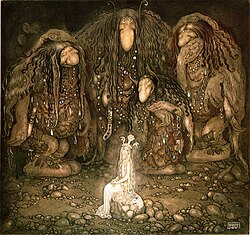Troll: Difference between revisions
Content deleted Content added
No edit summary |
←Replaced content with '{{About|the mythical beings|other uses|Troll (disambiguation)}} [[Image:John Bauer 1915.jpg|250px|thumb|''Look at them, troll mother said. Look at my sons! You ...' |
||
| Line 2: | Line 2: | ||
[[Image:John Bauer 1915.jpg|250px|thumb|''Look at them, troll mother said. Look at my sons! You won't find more beautiful trolls on this side of the moon.'' (1915) by [[John Bauer]]]] |
[[Image:John Bauer 1915.jpg|250px|thumb|''Look at them, troll mother said. Look at my sons! You won't find more beautiful trolls on this side of the moon.'' (1915) by [[John Bauer]]]] |
||
In [[Norse mythology]], a '''troll''' is a basterd |
|||
In [[Norse mythology]], a '''troll''' is a generally negative synonym for ''[[jötunn]]''. Later, in [[Scandinavian folklore]], trolls became beings in their own right. In modern times trolls are depicted in a variety of media. |
|||
In Norse mythology, ''troll'', like ''[[thurs]]'' is a term applied to jötnar. In Old Norse sources, trolls are said to dwell in isolated mountains, rocks, and caves, sometimes live together (usually as father-and-daughter or mother-and-son), and are rarely described as helpful or friendly.<ref name= "ORCHARD1997167">Orchard (1997:167).</ref> |
|||
There is much confusion and overlap in the use of Old Norse terms ''jötunn'', ''troll'', ''þurs'' and ''risi''. [[Lotte Motz]] theorized that these were originally four distinct classes of beings; lords of nature (''jötunn''), mythical magicians (''troll''), hostile monsters (''þurs'') and heroic and courtly beings (''risi'') - the last class being the youngest addition. Ármann Jakobsson calls this theory "unsupported by any convincing evidence" and argues that since the sources disagree, it may be most fruitful to investigate each text separately.<ref>Ármann Jakobsson 2006.</ref> |
|||
Later, in Scandinavian folklore, trolls become defined as a particular type of being, generally held to be larger than humans and notably ugly.<ref name= "SIMEK335">Simek (2007:335).</ref> Numerous tales about trolls are recorded, in which they are frequently described as being extremely old, very strong, but slow and dim-witted. They are sometimes described as man-eaters and as turning to stone upon contact with sunlight. Into the 20th century, the origins of particular Scandinavian landmarks, such as particular stones, are ascribed to trolls.<ref name="KVEDELAND-SEHMSDORF-301-313">Kvedelund, Sehsmdorf (2010:301–13).</ref> |
|||
A Scandinavian folk belief that lightning frightens away trolls and jötnar appears in numerous Scandinavian folktales, and may be a late reflection of the god [[Thor]]'s role in fighting such beings. In connection, the lack of trolls and jötnar in modern Scandinavia is explained as a result of the "accuracy and efficiency of the lightning strokes".<ref name="LINDOW89">Lindow (1978:89).</ref> |
|||
==Notes== |
|||
{{Commons category|Trolls}} |
|||
{{Reflist}} |
|||
==References== |
|||
{{Refbegin}} |
|||
* Ármann Jakobsson (2006). "The Good, the Bad and the Ugly: ''Bárðar saga'' and Its Giants" in ''The Fantastic in Old Norse/Icelandic Literature'', pp. 54-62. Available online at http://www.dur.ac.uk/medieval.www/sagaconf/armann.htm |
|||
* Kvideland, Reimund. Sehmsdorf, Henning K. (editors) (2010). ''Scandinavian Folk Belief and Legend''. [[University of Minnesota Press]]. ISBN 978-0-8166-1967-2 |
|||
* [[John Lindow|Lindow, John]] (1978). ''Swedish Folktales and Legends''. [[University of California Press]]. ISBN 0-520-03520-8 |
|||
* Orchard, Andy (1997). ''[http://books.google.com/books?id=5hbPHQAACAAJ Dictionary of Norse Myth and Legend]''. [[Orion Publishing Group|Cassell]]. ISBN 0-304-34520-2 |
|||
* [[Rudolf Simek|Simek, Rudolf]] (2007) translated by Angela Hall. ''[http://books.google.com/books?id=Zni8GwAACAAJ Dictionary of Northern Mythology]''. [[Boydell & Brewer|D.S. Brewer]] ISBN 0-85991-513-1 |
|||
{{Refend}} |
|||
{{Scandinavian folklore}} |
|||
{{Norse mythology}} |
|||
[[Category:Scandinavian folklore]] |
|||
[[Category:Germanic mythology]] |
|||
[[Category:Germanic legendary creatures]] |
|||
[[Category:Jötnar]] |
|||
[[af:Trol]] |
|||
[[az:Troll]] |
|||
[[bg:Трол]] |
|||
[[ca:Troll]] |
|||
[[cs:Troll (severská mytologie)]] |
|||
[[cy:Trol]] |
|||
[[da:Trold]] |
|||
[[de:Troll (Mythologie)]] |
|||
[[et:Trollid]] |
|||
[[el:Τρολ]] |
|||
[[es:Trol]] |
|||
[[eo:Trolo (mitologio)]] |
|||
[[eu:Troll]] |
|||
[[fa:ترول]] |
|||
[[fr:Troll]] |
|||
[[gl:Troll (mitoloxía)]] |
|||
[[ko:트롤]] |
|||
[[id:Troll]] |
|||
[[is:Tröll]] |
|||
[[it:Troll (mitologia)]] |
|||
[[he:טרול]] |
|||
[[ka:ტროლები]] |
|||
[[lt:Troliai]] |
|||
[[hu:Troll]] |
|||
[[arz:ترول]] |
|||
[[ms:Troll]] |
|||
[[nl:Trol (mythologisch wezen)]] |
|||
[[ja:トロール]] |
|||
[[no:Troll]] |
|||
[[nn:Troll]] |
|||
[[pl:Troll (mitologia)]] |
|||
[[pt:Troll]] |
|||
[[ro:Trol]] |
|||
[[ru:Тролль]] |
|||
[[sco:Trowe]] |
|||
[[scn:Troll]] |
|||
[[simple:Troll]] |
|||
[[sr:Трол]] |
|||
[[fi:Peikko]] |
|||
[[sv:Troll]] |
|||
[[th:โทรลล์]] |
|||
[[tr:Troll]] |
|||
[[uk:Троль]] |
|||
[[zh:巨怪]] |
|||
Revision as of 21:42, 7 March 2011

In Norse mythology, a troll is a basterd
